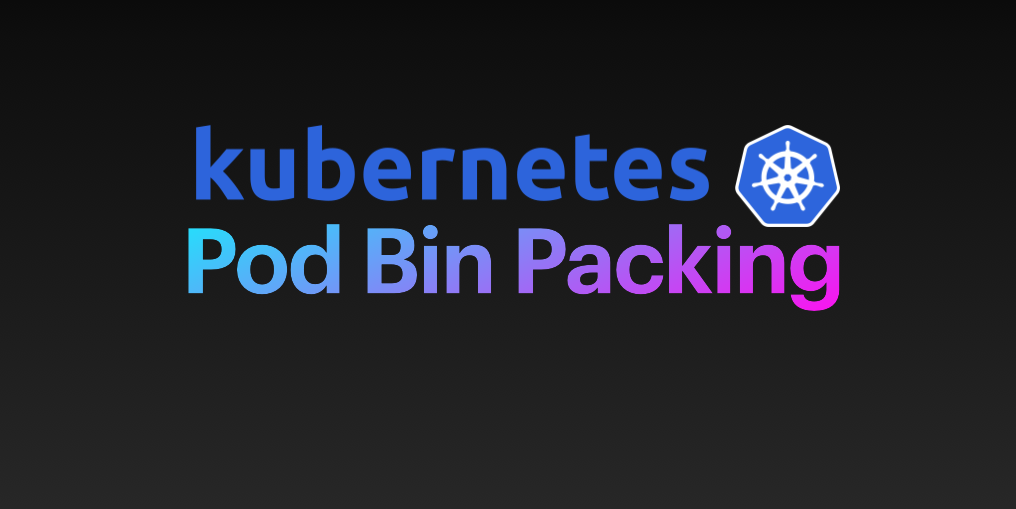Understanding Pod Bin Packing
 Ashis Padhi
Ashis Padhi
"Think of moving to a new apartment. You've got to pack furniture, kitchenware, books, and clothes into a limited number of boxes. To do it efficiently, you need to plan. You don't want some boxes half-empty while others are overflowing—that's wasteful and inefficient."
Similar thing applies to Kubernetes. The "bins" are your nodes, and the "items" are your pods. Pod bin packing is about efficiently placing pods onto nodes, ensuring you're not wasting resources while avoiding overload.
Why is this important ?
Imagine you're managing a large Kubernetes cluster. Poor bin packing means underused nodes, high infrastructure costs, and inefficient energy use. Good bin packing, however, optimizes resources, reduces the number of nodes you need, and balances workloads for resilience and flexibility.
Overview
The goal is to implement a plugin that helps place pods onto nodes in a way that optimizes resource utilization, minimizing resource fragmentation and reducing overall node count. This guide assumes some familiarity with Go programming and Kubernetes architecture.
Prerequisites
A working Kubernetes cluster
Knowledge of Go programming
Kubernetes development environment set up (e.g., Minikube, kind)
Basic understanding of Kubernetes scheduler plugins
1: Set Up the Project
Create a new Go project and set up dependencies for Kubernetes plugin development.
Add necessary dependencies for Kubernetes plugin development:
mkdir binpacking-scheduler
cd binpacking-scheduler
go mod init binpacking-scheduler
go get -u k8s.io/kubernetes
2: Implement the Custom Plugin
Create a new Go file (plugin.go) to define the custom scheduling plugin for pod bin packing.
package main
import (
"context"
"fmt"
"k8s.io/kubernetes/pkg/scheduler/framework"
"k8s.io/kubernetes/pkg/scheduler/framework/plugins/noderesources"
)
// BinPackingPlugin is our custom plugin for bin packing.
type BinPackingPlugin struct {
handle framework.Handle
}
// Name returns the name of the plugin.
func (b *BinPackingPlugin) Name() string {
return "BinPackingPlugin"
}
// Score scores the nodes based on resource utilization.
func (b *BinPackingPlugin) Score(ctx context.Context, state *framework.CycleState, pod *v1.Pod, nodeName string) (int32, *framework.Status) {
// Simple example: Give a higher score to nodes with more available resources.
// This logic should be more complex for real-world scenarios.
nodeInfo, err := b.handle.SnapshotSharedLister().NodeInfos().Get(nodeName)
if err != nil {
return 0, framework.NewStatus(framework.Error, fmt.Sprintf("Error getting node info: %v", err))
}
// Example logic: Nodes with more available resources get higher scores.
availableCpu := nodeInfo.Allocatable.MilliCPU - nodeInfo.Requested.MilliCPU
availableMem := nodeInfo.Allocatable.Memory - nodeInfo.Requested.Memory
// This simple scoring function uses a weighted sum of available CPU and memory.
score := int32(availableCpu/100 + availableMem/1024)
return score, nil
}
// ScoreExtensions returns nil, as we don't need additional scoring behavior.
func (b *BinPackingPlugin) ScoreExtensions() framework.ScoreExtensions {
return nil
}
// Register the plugin with the framework.
func NewBinPackingPlugin(_ *framework.PluginsConfig, handle framework.Handle) (framework.Plugin, error) {
return &BinPackingPlugin{handle: handle}, nil
}
3: Configure Kubernetes to Use the Custom Plugin
After defining the custom plugin, configure Kubernetes to use it. This involves setting up a new scheduler configuration to integrate the plugin.
Create a new configuration file (
scheduler-config.yaml):apiVersion: kubescheduler.config.k8s.io/v1 kind: KubeSchedulerConfiguration profiles: - schedulerName: default-scheduler plugins: score: enabled: - name: BinPackingPluginRun the Kubernetes scheduler with the custom configuration:
Deploy a custom Kubernetes scheduler that uses the configuration file you created.
This typically involves running a separate scheduler in your Kubernetes cluster and setting the
KUBE_SCHEDULER_CONFIGenvironment variable to point to the configuration file.
4: Test and Monitor the Custom Plugin
After deploying the custom plugin, ensure that it's functioning as expected:
Deploy Test Pods:
- Create a deployment or set of pods to verify that the scheduler uses your custom plugin to assign pods to nodes.
Monitor Scheduling:
Use Kubernetes tools like
kubectl get pods -o wideto check where pods are scheduled.Use observability tools like Prometheus or Grafana to monitor resource utilization and ensure that the custom plugin is optimizing pod placement.
Conclusion
This guide provides a basic framework for creating a custom pod bin packing plugin for Kubernetes. In real-world scenarios, custom plugins typically require more complex logic and rigorous testing to ensure reliability and stability. Further reading on Kubernetes scheduling, Go development, and plugin integration is recommended for deeper understanding and robust implementation.
Subscribe to my newsletter
Read articles from Ashis Padhi directly inside your inbox. Subscribe to the newsletter, and don't miss out.
Written by

Ashis Padhi
Ashis Padhi
🔧 With over 4 years of experience in cloud infrastructure and DevOps, I’ve built a career grounded in continuous learning and resilience. Whether it’s mastering tools like Kubernetes, Terraform, and Datadog or troubleshooting complex production issues, I’ve always embraced challenges as opportunities to grow. From automating infrastructure provisioning with Terraform (saving 75% of setup time) to achieving 99.99% uptime for critical applications, I’ve driven measurable results through innovation and adaptability. Even in the face of challenges—like navigating the remote work shift and industry uncertainties—I’ve remained committed to delivering high-impact solutions and evolving with the ever-changing tech landscape. 🏆 Recognized with awards and a promotion for my dedication and impact, I’m passionate about learning new technologies and applying them to solve real-world problems. For me, resilience isn’t just about overcoming challenges—it’s about thriving in them. 🎓 B.Tech graduate in CSE (CGPA: 9.7), I’m eager to continue building scalable, reliable systems while exploring cutting-edge technologies. 📌 Core Skills: Kubernetes, Terraform (IaC), Docker, Python, GCP, AWS, Helm, CI/CD (GitLab, Argo CD, GitHub Actions), Datadog, TCP/IP, DNS, REST APIs, MySQL. ✍🏼 Find my articles at: https://hashnode.com/@akpashis 📩 Let’s connect: ashispadhi08@gmail.com